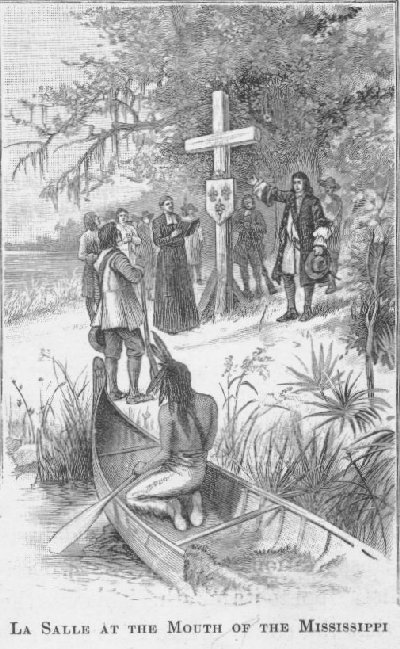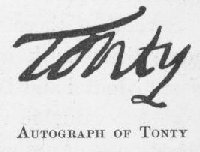In 1682 La Salle, seeking a trade route for the transportation of heavy skins, descended the Mississippi to its mouth. This was the first time that the entire course of the "Father of Waters" had been traversed by a white man. On April 9, on the shore near the mouth, he erected a column bearing the arms of France and an inscription, and took possession of "this country of Louisiana" from "the mouth of the great river St. Louis, otherwise called the Ohio, . . . as also along the river Colbert,5 or Mississippi, and the rivers which discharge themselves thereinto, from its source . . . as far as its mouth. . .

But after this triumph came a dangerous illness which kept him a prisoner at the Chickasaw Bluffs, while his faithful follower Tonty was dispatched to Michilli-mackinac6 with tidings of his success.  La Salle returned to France and was finally, in 1684, enabled to set sail for the mouth of the Mississippi with a force which was to build fortifications, establish a colony, and hold the country against the Spanish. Through an error they landed at Matagorda Bay, in Texas, and there followed a squalid period of privation, suffering, and discontent, culminating in a conspiracy of La Salle’s followers and the assassination of this brave explorer in 1687.
La Salle returned to France and was finally, in 1684, enabled to set sail for the mouth of the Mississippi with a force which was to build fortifications, establish a colony, and hold the country against the Spanish. Through an error they landed at Matagorda Bay, in Texas, and there followed a squalid period of privation, suffering, and discontent, culminating in a conspiracy of La Salle’s followers and the assassination of this brave explorer in 1687.
Several of those who served with La Salle made their mark in the early annals of the west. Joutel and Tonty, his loyal lieutenants, have left valuable records of adventurous explorations. Another less heroic figure was Father Hennepin, the discoverer of the Falls of St. Anthony at Minneapolis, who for a time accompanied La Salle. But Father Hennepin, unhappily, was romancer as well as historian.
To Pierre Le Sueur is due the credit of a journey in 1700 from the mouth of the Mississippi to the country of the Sioux, in the present state of Minnesota, and a return down the river. This journey was made in a profitless search for furs and mineral wealth. In the same year Pierre Le Moyne d’Iberville planned an expedition to the upper Missouri, lured by the hope of a western passage down some river to the western sea. In 1717 Hubert urged a similar plan upon the French Council of Marine.7 The belief in the myth of the northwest passage8 to the Orient was waning, but there was still faith, not wholly unfounded, in a nearly continuous river route to the western ocean, and, failing this, it was believed that a way could be made by land.
Under the regency of the Duke of Orleans, in 1716, three posts were planned between Lake Superior and Lake Winnipeg to serve as bases of supplies for an overland expedition, and one was actually built at the mouth of the river Kaministiguia on the north shore of Lake Superior. But nothing more was done, and three years later Charlevoix, the Jesuit historian of early Canada, was ordered to visit the country and report upon a passage to the western sea. His report was that the Pacific probably lay just to the west of the country of the Sioux. One plan which he advocated was the ascent of the Missouri. "the source of which is certainly not far from the sea."
Iberville and Charlevoix had pointed to the Missouri as the route nearly a century before the journey of Lewis and Clark. Then came the Verendryes, who preceded the Americans almost to the Rocky Mountains.
La Verendrye the elder, a French soldier, explorer, and trader, built forts at the Lake of the Woods, on the site of Winnipeg, and at the mouth of the Saskatchewan. In the course of his expeditions he traveled as far as the Mandan villages on the Missouri in his search for the western sea. This was in 1738. It was among the descendants of these Mandans living near Bismarck, Dakota, that Lewis and Clark passed a winter nearly seventy years later.

In 1742 the two sons of Verendrye made their way to the Mandan villages, and undertook an expedition westward, under the guidance of the Indians, hoping to find the Pacific. They traveled between the Black Hills and the Missouri, entered Montana, and finally, after much uncertain journeying and many strange experiences with the nomadic tribes of Indians, the mountains rose before them. The Spaniards had crossed the mountains to the south, but the Verendryes were the first white men to see the true Rocky Mountains on the north. It was in January, 1743, that they discovered the mountains, probably the Big Horn range in Wyoming. In the records of French Louisiana the names of the Verendryes merit a place with those of Father Marquette and La Salle.
5A short-lived name given in honor of the minister of finance of Louis XIV.
Return to text.
6 The name was applied generally by the French to the region about the Straits of Mackinac between Lake Huron and Lake Michigan. The island of Mackinac to the east was an early military post, and was also the first site of the mission of St. Ignace, afterwards transferred to the present site of St. Ignace on the mainland north of the straits, where Father Marquette was finally interred a year after his death in 1675 near the present site of Ludington, Michigan. A century later the English built a fort at the present site of Mackinaw City, south of the straits.
Return to text.
7In 1704 Bienvile reported that over one hundred Canadians were scattered along the Mississippi and Missouri. In 1705 a Canadian named Laurain claimed to have ascended the Missouri, and in 1708 Nicolas de la Salle proposed a plan like those of Iberville and Hubert. In 1719 Du Tisné ascended the Missouri above Grand River. Afterward he crossed the state of Missouri and reached the Indians on the Osage River. The early eighteenth-century explorations of Saint Denis, La Harpe, Bourgrnont, and the brothers Mallet, for the most part in the southern half of the Louisiana territory, in Texas, and even New Mexico, helped, in the language of Parkman ("A Half Century of Conflict "), "to unveil the remote southwest."
Return to text.
8 This idea represented a phase of the long search for a northwest passage to the Orient, which is perhaps most closely identified in the popular mind with the early attempts in the region of Hudson Bay and in the Arctic.
Return to text.
Chapter 3
Back to Legacy
© 2001, Lynn Waterman